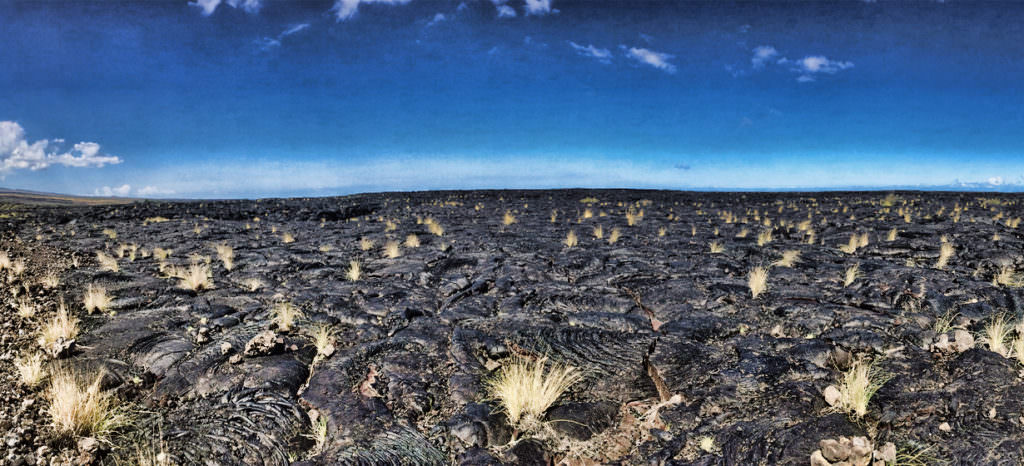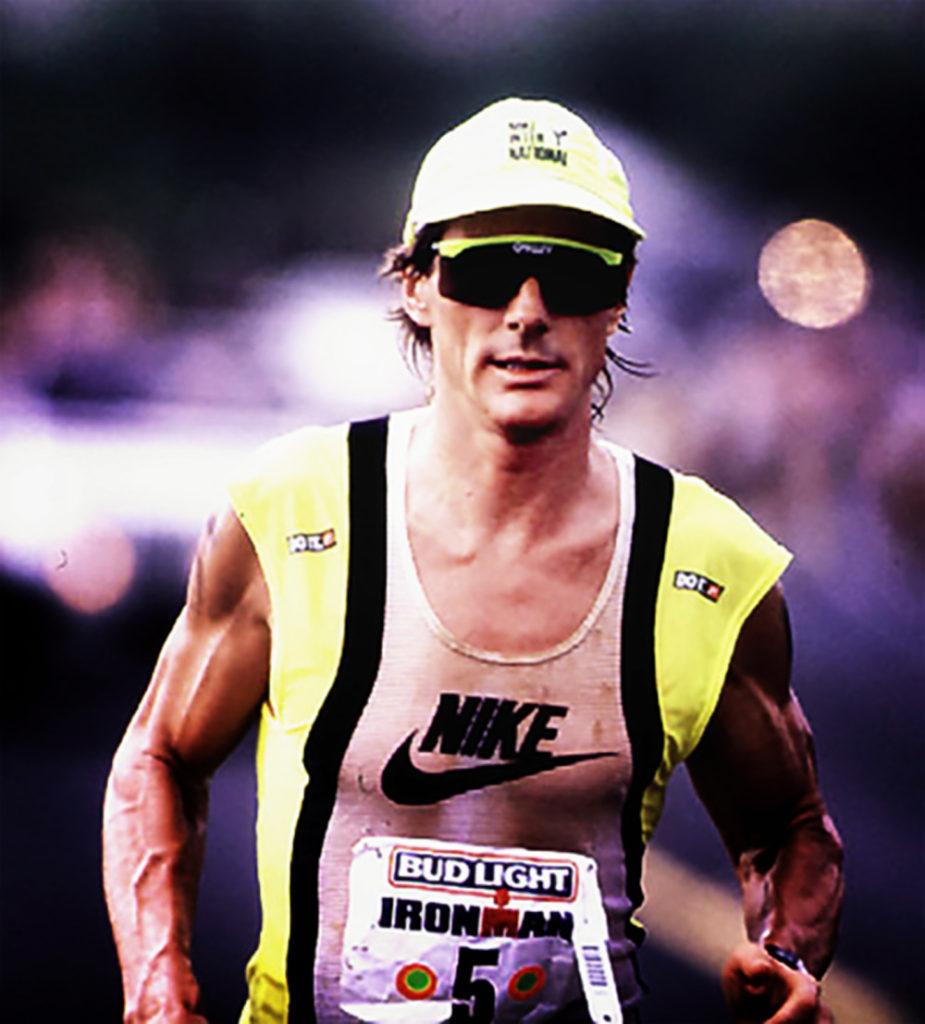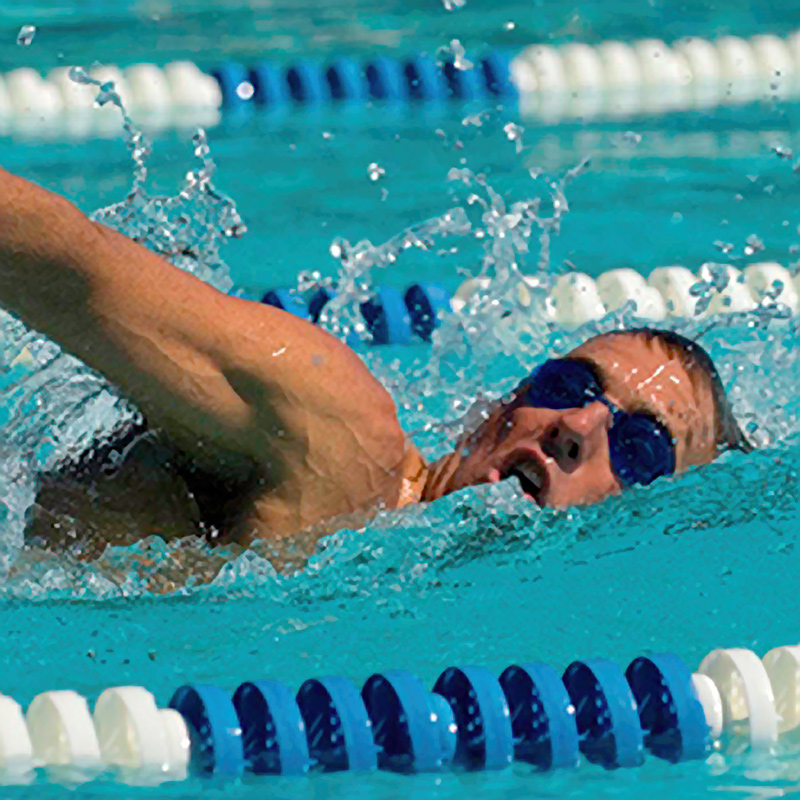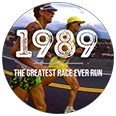INTRODUCTION
This is the ninth of ten untold stories about the incredible moments of personal challenge and the decisions made that led to the 1989 side-by-side eight-hour battle between Dave Scott and Mark Allen. Everyone has seen accounts of the race itself. Neither Dave nor Mark have told this story from each of their perspectives. But, more importantly, no one has ever heard the details of each of their personal journeys during the year leading up to The Greatest Race Ever Run.
Both Dave Scott and Mark Allen knew what it took to win races. Dave knew what it took to win in Kona. He had a formula. He was putting it in place each and every one of those closing seven day going into the 1989 Ironman World Championship. Mark had never won in six attempts. He was trying to ensure that this time would be different to achieve the greatest victory any triathlete could hope for. Each was putting the final polish on what had been weeks of punishing training. Both would be ready by Saturday October 14, 1989.
Without the support of the photographers who were kind enough to let us use their images this collection of stories wouldn’t have been complete. A huge shout out (and their names link to their websites should you ever find yourself in need of a great photographer), Rich Cruse, Dave Epperson, Jero Honda, and Mike Plant.
Scott Zagarino
Mark Allen
“For me, race week in Kona was actually ten days. I would fly in on the Wednesday a week-and-half-out from the Ironman to do my final bits of training on the Big Island. It was ten days with one singular focus: tune myself into what it would take to handle the intensity and challenges of the race that was coming on the eleventh day.
The immensity of Ironman drowns out worrying about the other competitors. For sure there would be moments when I would think about them, especially when I’d see them out training. But not even the overbearing aura of Dave Scott and his six victories came close to hitting me with the same terrifying fear I had about the fact that the race and the Island could chew me up and spit me out in a million broken pieces. I knew what a day gone bad could end up looking like. Two years earlier, I was bleeding internally and had to be rushed to the hospital right after crossing the finish line.
In all my previous six flights to Kona, the moment I looked down on the approach and saw the Queen K Highway, where the decisive moments of the race would place, I’d get something like vertigo. My head spun. My entire body broke out in a sweat. I saw the reality of where I had to race. The fear of it all enveloped me. And that was just the beginning. The fear would grow and grow and GROW until the starting cannon finally sounded on race morning.
But those hallowed ten-days before the race in 1989 were different. My first glimpse of the Island and the long ribbon of road where the race would unfold gave me an unexpected sense of peace. I knew the race would be at least as intense as every other year. But the sight of the lava brought me a feeling that no matter how the race went, I’d be okay. I kept waiting for the usual river of sweat to form all over my body—but it never happened.
Instead of dreading another showdown with Dave, I looked forward to trying something new. I had one strategy going into 1989, and that was to stay with “The Man” until the very end of the race. Previously, I’d tried going off the front on the bike. That didn’t work. So l tried pulling away from Dave early on the run. Both of those strategies failed miserably. Each ended up with complete meltdowns late in the marathon.
No, this year, if I was strong enough to match his pace, I’d learn from the best in the sport how to pace it. I’d stick with Dave until there was no question that the finish was close enough to ensure there would be no collapse.”

Dave Scott
“Collectively, my three close friends—Mike, Pat, and John, plus my sister Jane—had a direct bead on my mental and physical makeup. They had experienced my highs and lows throughout the years. They understood that if I was mentally ready for the race, I would have the ability to prevail and win world championship number seven.
Pat’s profession is physics. He specializes in crunching scientific data. His meticulous insight into the 1989 IRONMAN race was extremely thorough and detailed. He always presented thought-provoking scenarios in regards to how I was going to win my seventh race in Kona.
John was keenly aware of my training fluctuations, generally manifested by my fear of failure. He was always willing to bolster my morale. When we landed in Kona, his upbeat personality added lightness and levity to the approaching race day.
On the Wednesday of race week in 1989, I sat in my condo along Aliʻi Drive, which lies adjacent to the IRONMAN marathon course. I shared my strategy with.. and they listened—and simultaneously offered their historical and valuable perspectives. The plan was put into place.”
Mark Allen
“I had modified many aspects of my Kona preparation that year. I’d trained in New Zealand in the winter. That had worked. I’d broken from Ironman focus mid-season and raced in Avignon. Although there had been some very rocky moments in that choice, it had ended up adding to my fitness for Hawaii. And even where I would park myself for that final countdown to the race in Kona was going to be different this year. In every other year, I’d stayed in town as close to the race start as I could. But in 1989, I rented a condo six miles south of the hubbub, just a few blocks away from where the bike-to-run transition would be.
Town was hectic and busy and noisy. My newfound spot was calm and peaceful and uncrowded. The only sound I heard was the ocean from the lanai of my new home-away-from-home. The whole setup was completely in line with how I am hardwired.
The contrast made me realize that in all my earlier Ironman attempts I had tried to be like Dave. He got pumped up with an invincible energy when he set foot on the Island. I tried to feel that same pumped-up, unbeatable strength. But from the moment I entered my new quiet sanctuary looking out at the ocean, I knew it was right to be there in Hawaii as me, with strength that was in no way similar to Dave’s.
My strengths flourish when I am quiet, peaceful, and looking out at nature. I feel strong when I stop thinking, when I let my energy settle. I’d known this in the past, but I also hadn’t thought there was any way that quiet and peaceful would be what would enable me to match the intensity of the Ironman. I felt like I had to be pumped up to manage the immense amount of force the Island served up on race day.
But in that first moment on the lanai looking out at the beautiful blue Pacific, I finally realized that even if it wasn’t what would bring me victory, I had to race as me and no one else. Dave could be pumped up and invincible. I’d have to figure out how to be quiet and patient, to feel peace in a place that for years had been hell for me.”

Dave Scott
“During race week, I had a structured training program that allowed me adequate recovery, but my methodology also included enough physical stimulus to trigger the morphine-like endorphins required to satiate my mind. If I just went “easy” during race week, my mind… . My vulnerability was keeping my emotional state primed by having quality sessions during my first three days in Kona. Sunday, Monday, and Tuesday would be key training days.
Tuesday’s session in all my pre-IRONMAN race weeks was pretty consistent:
- I swam the course with the last half just a tad slower than race speed.
- I cycled 45 miles (79km) with 4 segments of 15’ at race speed.
- I ran 8 miles (13km) with the final 4 miles (6km) on Aliʻi Drive at 6’ (3’45”/km).
The combined workouts were comfortably hard and boosted my readiness for the race.
Sitting with me in my condo, my wife, Anna (and my son, Ryan), along with John, Pat, Mike, and Jane were all interested in hearing my race plan. Starting with the swim, my strategy was two-fold.
First, I knew Mark would be right next to me at the start along with a very tight group of professionals that would either want to follow or stay with me. Each year the aggressiveness at the start escalated exponentially and it was paramount that I get out quickly and without taking inadvertent pushes and grabbing from everyone else. The start would inevitably become a clawing match to hold the pace, and to rid myself of the athletes who would nearly swim on top of me. Going out fast, really fast, was the goal. Even with an ideal start and not having to shed other competitors, I knew Mark had an uncanny ability to follow my feet and this year would be no different.
Second, I would accelerate away from Mark when I felt there might be a gap and, more importantly, when I felt strong throughout the swim. The intention was to create an added level of discomfort for Mark, both physically and mentally. Whether this discomfort would actually manifest? Well, the race would tell the story.”
Mark Allen
“When you are invited into someone’s home, you often bring a gift, an offering. The Island of Hawaii was like a home I’d entered many times in my life, even before I first came to race the Ironman. But I’d never brought a gift in exchange for the chance to be there.
In 1989, I had my offering. It was the dried grasses from the lagoon near my home in San Diego that reminded me of a place where I always felt good. With those grasses in hand, I headed to a little church that sits on a lava buttress looking out over the ocean on Ali’i Drive. I don’t go to church, but I figured it would be a good place to try to tune into something greater than myself. It was right next to a sacred heiau, a Hawaiian temple. I really wanted to go there, but I wasn’t sure if I was allowed. So, the church would have to do.
It’s was a small blue wooden structure big enough to seat ten or fifteen people at most. I walked in. I put my grasses on the front altar where other offerings had been left. Then I sat down and, for the first time, I spoke to the Island. I asked that it be okay to come there with my strength and that my strength would be good enough. I asked the Island to accept my presence and my offerings, and to that I could simply have a good race.
It was nearing sunset. I was the only person in the church, but I could sense I wasn’t alone. I closed my eyes. And then I saw, as we all do when images come to us in a dream or a vision, standing right in front of me was a committee of Island elders. One of them spoke but it was a universal voice that said, “You can have what you have come here for. But it’s going to take courage.”
Was it a vision? It felt like one. Did I make it all up in my mind? I doubt it because it felt as clear as the most lucid moments I’d ever experienced in my life. Had I finally connected with the spirit of the Island that I had felt so strongly in all the past years but had tried to hide from rather than embrace? That was for sure.
I was elated. In a deep way, I finally made a real, peaceful connection with Hawaii. I felt I could have the race I’d been seeking to have for so many years. But I also knew there would be a catch to the warning that it would take “courage.”

Dave Scott
“Mike knew and understood what my swim pace would be over the first ten minutes of the race (approximately 800+ meters). The pace would be flat out!
I never distinguished between an Olympic-distance swim (.9 mile/1500m) and an IRONMAN swim (2.4 miles/3800m). I would hold my top speed not just to sting Mark but to hopefully get on the feet of a select group of very fast swimmers that included Wolfgang Dietrich of Germany. My goal was to get under 50’. The discussion we had that day on the swim was limited but my team knew my weakness was my top-end speed and it would be vital for me to attack the opening quarter of the swim.
My strategy on the cycling leg was open for input. Similar to the swim, my approach would be to ride the initial 25 miles (40km) at an Olympic-distance (40km) speed. I knew Mark was fast and to trigger the first hour of cycling with a psychological exclamation was my formula to take the overall lead in the race. My motive was simple—to send out an early forecast to Mark and anyone else that the pace was going to be relentless.
Pat asked how I would break down the 112-mile (180km) ride. He wanted to know the definable and tangible segments where I would up the tempo. My strength was time trialing and grinding away on relatively flat segments. A windy day just heightened my ability, or at least this is what I thought from my previous IRONMAN races . It was also validated by my competitors and the media statements that “Dave Scott relishes the brutal conditions.” As I have mentioned before, I never allowed the conditions to determine the fate of my race. If Mark or the others were mentally plagued by a potentially harsh day, this would be favorable for me.
Pat and Mike asked when I would make my move if the race ended up being close. I was a bit worried about the 7-mile (12km) cycling climb to Hawi, which is the turn-around heading back to Kailua. Mark was always strong on the climbs and I would have to be smooth, using a combined technique of seated and standing riding. Throughout the ride alternating seated and standing position always reminded me to keep my hip flexors open and back relaxed in preparation for the run—because the run might ultimately decide the fate of the day. But, if Mark was ready to surge on the climb, I would stay with him.
Answering Pat and Mike’s question about my plan, I replied that I would wait until we completed the 19-mile (31km) rolling descent to the hottest point on the course, the port town of Kawaihae. At that point in the race, having covered 72 miles (120km), I would increase my tempo for three or four miles—and break Mark and everyone else who was still hanging on. Pat brought a sobering reminder to my vision of how this tactic would play out on the flats, stating that it may take me a few efforts to break free, not just one.
Mike was confident that my time trialing was strong and this race overview might work, but he felt it would ultimately come down to the marathon. Mike knew my greatest strength was the run. Jane and John also agreed my run performance had never failed me an IRONMAN. I had run 2 hours 45’ in Japan and my goal was to run seven to eight minutes faster on race day—in just four days.”
Mark Allen
“Dave fielded the lion’s share of the questions at the press conference. He was doing the race for himself and for his newborn son. I was still unproven and barely visible in his shadows. No one was even interested in asking me much. I had six races in Kona, no victories, and a lot of collapses. I was asked the usual “how are you feeling this year” question. But I could tell no one in that room thought I had a chance of doing anything different. Bridesmaid was the best they saw in me.
And to be honest, it hurt. Everyone had lost confidence in me. I had gotten to know most of the people in the room well over the previous seven years. Many were close friends.
And no one gave me a chance of winning.
Maybe I was living in false hope. Perhaps everyone else was right and seeing the reality that I would never be the next to take the charge. But the Island had given me confidence. And that was the invincible force I would race to honor in two days’ time.”
